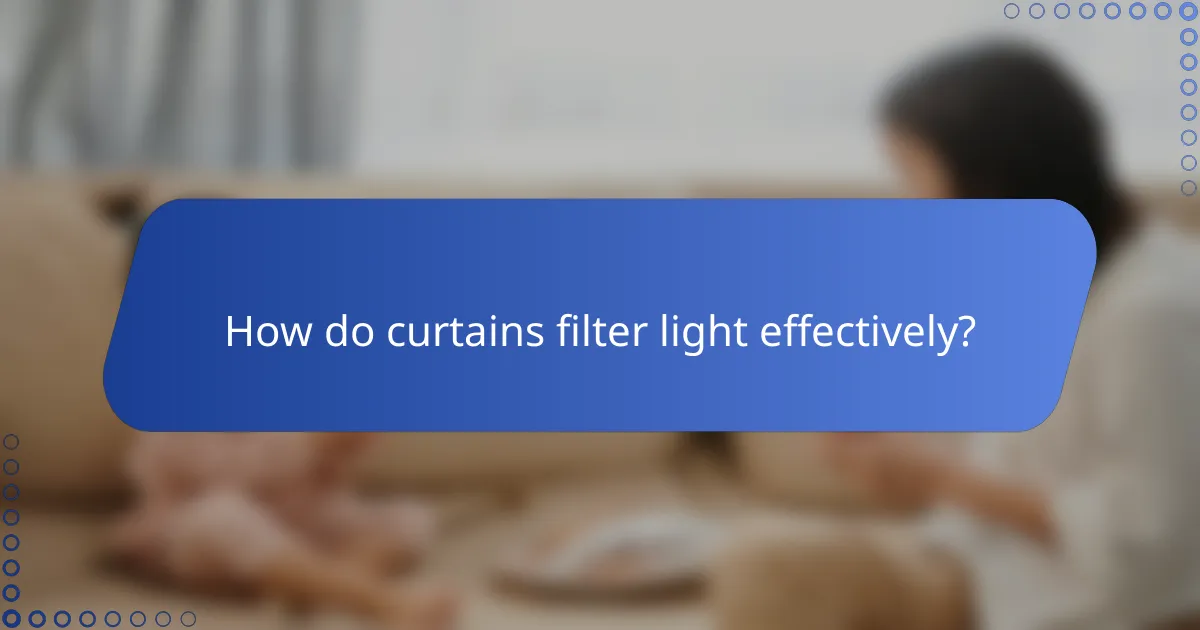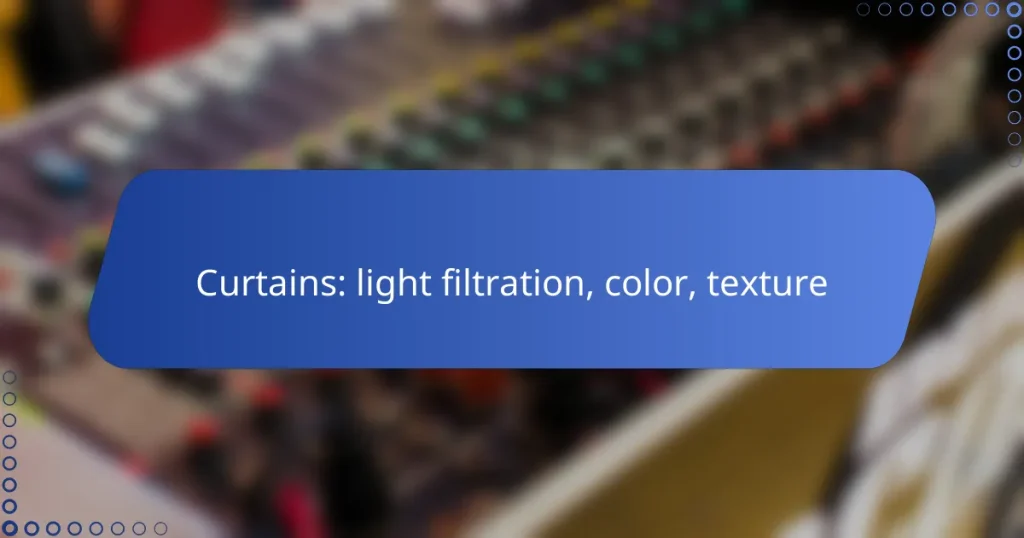Curtains play a crucial role in light filtration, utilizing various materials and weaves to control sunlight in any room. The selection of fabric, color, and texture not only impacts the ambiance but also allows homeowners to tailor their spaces to reflect personal style and comfort. From neutral tones to bold shades, the right curtains can enhance both the aesthetic and functionality of your living environment.

How do curtains filter light effectively?
Curtains filter light effectively by utilizing different materials and weaves that control the amount of sunlight entering a room. The choice of fabric, thickness, and color significantly influences how light is diffused, creating various atmospheres in your living space.
Sheer curtains for soft light
Sheer curtains are designed to allow natural light to flow into a room while providing a soft, diffused glow. Made from lightweight fabrics, they gently filter sunlight, reducing glare without completely blocking it. This makes them ideal for spaces where you want to maintain brightness while ensuring privacy.
When selecting sheer curtains, consider colors that complement your decor. Light shades like white or pastel hues enhance the airy feel, while darker sheers can create a more dramatic effect. Keep in mind that sheer curtains work best in areas where direct sunlight is not overwhelming.
Blackout curtains for total darkness
Blackout curtains are specifically designed to block out nearly all light, making them perfect for bedrooms or media rooms. These curtains are typically made from thicker, opaque fabrics that prevent sunlight from penetrating, ensuring complete darkness when needed.
When choosing blackout curtains, look for options with a lining or a special coating for maximum effectiveness. They are particularly beneficial for shift workers or anyone needing to sleep during the day. Ensure that the curtains are properly fitted to the window to minimize light leakage around the edges.
Light-filtering curtains for balanced illumination
Light-filtering curtains strike a balance between sheer and blackout options, allowing some light to enter while providing a degree of privacy. These curtains are made from semi-opaque fabrics that diffuse sunlight, creating a warm and inviting atmosphere without sacrificing too much brightness.
For optimal results, select light-filtering curtains in colors that match your interior design. They are versatile and can be used in various rooms, from living areas to home offices. Consider layering them with sheer curtains for added flexibility in light control throughout the day.

What colors are popular for curtains in the UK?
In the UK, popular curtain colors include neutral tones, bold shades, and soft pastels. These choices cater to various interior styles and preferences, allowing homeowners to enhance their spaces effectively.
Neutral colors for versatility
Neutral colors such as whites, beiges, and greys are favored for their versatility. They easily blend with different decor styles, making them suitable for both modern and traditional interiors.
When selecting neutral curtains, consider fabrics that add texture, like linen or cotton, to prevent the space from feeling flat. This can create a warm and inviting atmosphere while maintaining a sophisticated look.
Bold colors for statement pieces
Bold colors like deep reds, vibrant blues, and rich greens can serve as striking statement pieces in a room. These hues draw attention and can dramatically change the mood of a space.
When using bold curtains, balance them with more subdued furnishings to avoid overwhelming the room. It’s also wise to consider the amount of natural light the space receives, as bold colors can appear different under varying lighting conditions.
Pastel colors for a soft look
Pastel colors, including soft pinks, light blues, and mint greens, are popular for creating a gentle and calming atmosphere. These shades work well in bedrooms and living areas where a serene environment is desired.
To enhance the soft look, choose lightweight fabrics like sheer or chiffon that allow light to filter through. This not only adds to the aesthetic but also helps maintain a bright and airy feel in the room.

How does texture impact curtain choice?
Texture significantly influences curtain choice by affecting the overall aesthetic, light filtration, and warmth of a space. Different materials provide unique visual and tactile qualities, which can enhance or alter the ambiance of a room.
Velvet for luxury and warmth
Velvet curtains are synonymous with luxury, offering a rich, plush texture that adds depth to any room. Their thick fabric effectively blocks light, making them ideal for bedrooms or media rooms where darkness is desired.
When choosing velvet, consider colors that complement your decor. Deep jewel tones can create a dramatic effect, while lighter shades can soften a space. Keep in mind that velvet requires more maintenance, as it can attract dust and may need professional cleaning.
Linen for a casual, airy feel
Linen curtains provide a relaxed, breezy atmosphere, perfect for casual living spaces. Their lightweight nature allows for soft light filtration, creating a warm glow without completely darkening the room.
Opt for linen if you want a natural look; it wrinkles easily, which can enhance its charm. Choose lighter colors for a brighter feel or earthy tones for a more grounded aesthetic. Linen is also relatively easy to care for, making it a practical choice for everyday use.
Silk for elegance and shine
Silk curtains exude elegance and sophistication, featuring a smooth texture that reflects light beautifully. They are ideal for formal settings, adding a touch of glamour to dining rooms or living areas.
While silk offers stunning visual appeal, it is less durable than other fabrics and can fade in direct sunlight. Consider using silk in spaces where they won’t be exposed to harsh light. Regular cleaning and careful handling are essential to maintain their luxurious appearance.

What factors should you consider when choosing curtains?
When choosing curtains, consider the room’s purpose, the desired light filtration, fabric durability, and how the style complements your decor. These factors will help you select curtains that enhance both functionality and aesthetics in your space.
Room purpose and light needs
The purpose of the room significantly influences your curtain choice. For example, in a bedroom, you might prefer blackout curtains for privacy and light control, while in a living room, sheer curtains can allow natural light while maintaining some level of privacy.
Evaluate how much light you want to filter in. Rooms that require bright, natural light, such as kitchens or offices, may benefit from lighter fabrics, while spaces meant for relaxation might need heavier materials that block out more light.
Fabric durability and maintenance
Durability is crucial, especially in high-traffic areas or homes with pets and children. Fabrics like polyester and blends tend to be more resistant to wear and tear compared to delicate materials like silk.
Maintenance is another important consideration. Some fabrics are machine washable, while others may require dry cleaning. Opt for easy-care options if you prefer low-maintenance solutions, particularly in areas prone to spills or stains.
Style compatibility with decor
Your curtains should harmonize with the overall decor of the room. Consider the color palette, patterns, and textures of your furnishings. Neutral colors can provide versatility, while bold patterns can serve as statement pieces.
Additionally, think about the curtain style—whether you prefer rod-pocket, grommet, or tab-top designs—as these can affect the room’s visual flow. Aim for a cohesive look that enhances your existing decor rather than clashes with it.

How do curtain styles differ?
Curtain styles vary primarily in their installation methods, aesthetics, and functionality. Understanding these differences can help you choose the right curtains for your space, considering factors like ease of use, design preferences, and light filtration needs.
Rod pocket curtains for easy installation
Rod pocket curtains feature a sewn-in pocket at the top, allowing the curtain rod to slide through easily. This design makes installation straightforward, as you simply need to thread the rod through the pocket and hang it up.
These curtains are ideal for casual settings and can be made from various fabrics, providing options for light filtration. However, they may not offer as much versatility in terms of adjusting the height or creating a tailored look compared to other styles.
Grommet curtains for modern aesthetics
Grommet curtains utilize metal rings at the top, which slide over the curtain rod, creating a sleek and contemporary appearance. This style allows for smooth opening and closing, making them practical for everyday use.
Grommet curtains are available in numerous colors and textures, enhancing their visual appeal. They are particularly effective at blocking light and can be a stylish choice for bedrooms or media rooms, where light control is essential.


